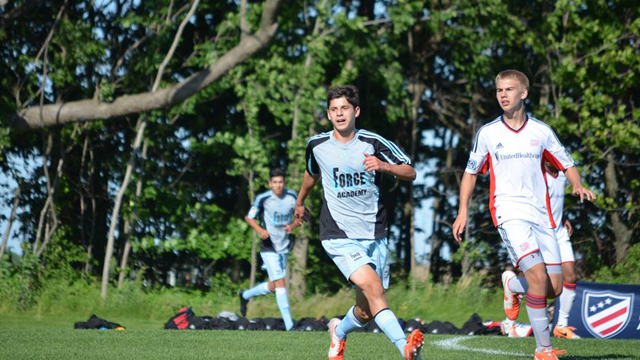De Anza Force’s Shaun Tsakiris on how winning less means developing more in DA

CUPERTINO, Calif. –After making a cutting run into the box, De Anza Force and U.S. Under-15 striker Adolfo Trujillo took a lofted pass in stride, moved the ball to his shooting foot, and buried it past the outstretched fingertips of the opposing goalkeeper.
 Trujillo’s goal was the kind of goal that American soccer fans have long been begging for: dynamic movement off the ball, incisive combination passing and a brilliant, almost effortless finish.
Trujillo’s goal was the kind of goal that American soccer fans have long been begging for: dynamic movement off the ball, incisive combination passing and a brilliant, almost effortless finish.
+ READ: De Anza Force building Development Academy, ECNL programs from bottom up
It’s the kind of creative attacking play that U.S. Soccer’s Development Academy system was supposed to produce at every level of the soccer pyramid, but which has long been neglected in favor of the defensive long ball that wins trophies and keeps the pay-to-play system functioning.
Last Saturday’s match between the De Anza Force U-15/16s and Real So Cal, which Real went on to win 4-1, demonstrated a critical, and often overlooked, aspect of the Development Academy system: Winning now matters far less than it once did.
Freed from the constraints of the trophy hunt, Development Academy coaches are able to shift their clubs’ emphasis towards individual player development. Their emphasis now is on passing out of the back and on the process of creating a goal, to a point where the goal itself becomes an almost irrelevant byproduct of creative play.
“We’re not super concerned about what other people are thinking,” De Anza Force U-15/16 coach Shaun Tsakiris told SoccerWire. “We have ideas and a path that we want our players to be on. I’ve gone over the film [of last weekend’s matches] a couple of times and I actually think that we played much better in the game that we lost than the game that we tied.”
“Of course, it’s always more enjoyable to win the matches,” Tsakiris continued. “But we have a longer goal in place, which is: Can we prepare our guys for the next level? If we’re getting our players prepared and developing them every week and having that [development] mentality, [then] I don’t want to say it’s irrelevant, but it’s not the end-all, be-all if we won the game or lost the game.”
The training environment ushered in by the DA is markedly different from the one that first molded Tsakiris, a former U.S. youth international who once played with the likes of Taylor Twellman, Tim Howard, and Carlos Bocanegra. Growing up in nearby Saratoga, Tsakiris played for his uncle at local club De Anza Cleats. There, he practiced only twice a week, even as he was involved with U.S. youth national teams.
Today, Tsakiris says, there’s almost no comparison.
“I think the biggest difference between what U.S. Youth Soccer was about then and what it is [about] now is the federation is mandating that we train a certain way and we train a certain amount of hours and we’re held to a standard. I love that. I think it’s great,” he says.
+ READ: SW Q&A: Development Academy debutants PWSI eager to seize opportunity
But old habits die hard. And getting both players and parents on board with the Development Academy program is an ongoing challenge for coaches like Tsakiris.
“It’s never easy,” he said. “Especially [in] the country we live in, [where] everything’s about winning and everything’s about ‘We won State Cup’ and ‘We won District Cup.’
“The second you put your priorities [on] winning, the development will for sure suffer.”
The goal for teams like De Anza Force is to develop the individual player, whether for college, the pros or the national team. But this can only happen, Tsakiris insists, when the entire team is playing well together.
“I make it very, very clear that I really believe this: that everybody will be recognized if the group is playing well. Everybody will have a breakout year if we put the team first.”
While Tsakiris’s current squad features such highly regarded prospects as Trujillo, defender Jonathan Navarro and forward Vernon Fernandez, the coach is quick to point out that no single player is greater than the team.
+ READ: An alternative to our youth soccer development structure – more free play
“Our goal is to get better [as a team]; by the end of the season we’re a better team than we are now. By the end of the season, you are a better footballer than you are now.”
In an age of YouTube highlight reels, national player rankings, and the increasing commodification of young soccer players, the Development Academy system is in a unique position to change the mentality of players, parents and coaches. By shifting the emphasis away from winning trophies and toward the development of individual talents, and eventually by eliminating pay-to-play, the academies could radically alter the way we identify and train America’s best young soccer talents.
It will doubtless take Herculean effort and considerable involvement from U.S. Soccer to overturn decades of tradition in a cultural mentality that venerates winning at all costs. But clubs like De Anza Force and coaches like Tsakiris are proving that change can come, one player at a time.












